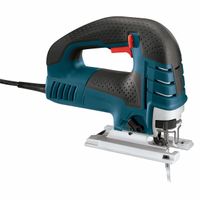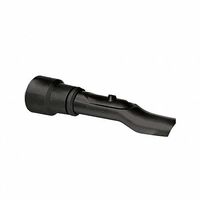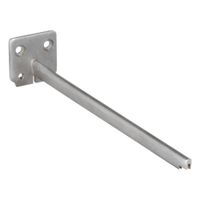Call +(254) 703 030 000 / 751 483 999 / 721 704 777
- Home
- Tools
- Power Tools
- Power Saws Blades
- Jigsaws
.....Read More
Frequently Asked Questions
What is a jigsaw used for?
A jigsaw is a versatile power tool used primarily for cutting curves and intricate shapes in various materials such as wood, metal, plastic, and ceramic. It features a small, straight blade that moves up and down rapidly, allowing for precise and controlled cutting. The jigsaw is particularly useful for tasks that require detailed and complex cuts, which are difficult to achieve with other saws.
One of the key advantages of a jigsaw is its ability to make both straight and curved cuts, making it ideal for cutting out patterns, stencils, and designs. It is commonly used in woodworking, carpentry, and DIY projects for tasks like cutting out shapes in furniture, creating decorative pieces, or fitting countertops and sinks.
Jigsaws are also equipped with adjustable speed settings, allowing users to tailor the cutting speed to the material being worked on, ensuring clean and accurate cuts. The tool's compact size and lightweight design make it easy to handle and maneuver, even in tight or awkward spaces.
Additionally, jigsaws can be fitted with a variety of blades designed for specific materials and cutting requirements. For example, fine-toothed blades are used for smooth cuts in wood, while coarser blades are suitable for faster, rougher cuts. Special blades are also available for cutting metal or ceramic tiles.
Overall, the jigsaw is an essential tool for anyone involved in detailed cutting work, offering flexibility, precision, and ease of use across a wide range of applications.
How do you change a jigsaw blade?
1. **Unplug the Jigsaw**: Ensure the jigsaw is unplugged from the power source to prevent accidental starts.
2. **Locate the Blade Clamp**: Identify the blade clamp mechanism, which is usually near the front of the jigsaw. This can be a lever, screw, or knob depending on the model.
3. **Release the Blade**:
- **Lever System**: Flip or turn the lever to release the blade.
- **Screw System**: Use a screwdriver to loosen the screw holding the blade.
- **Knob System**: Turn the knob counterclockwise to loosen the blade.
4. **Remove the Old Blade**: Carefully pull the old blade out of the clamp. Be cautious of sharp edges.
5. **Select the New Blade**: Choose a blade suitable for the material you will be cutting. Ensure it is the correct size and type for your jigsaw.
6. **Insert the New Blade**:
- Align the new blade with the blade holder, ensuring the teeth face forward.
- Insert the blade into the clamp until it is securely seated.
7. **Secure the Blade**:
- **Lever System**: Flip or turn the lever back to lock the blade in place.
- **Screw System**: Tighten the screw to secure the blade.
- **Knob System**: Turn the knob clockwise to tighten the blade.
8. **Check Blade Alignment**: Ensure the blade is straight and properly aligned with the guide roller.
9. **Test the Blade**: Plug the jigsaw back in and perform a test cut on scrap material to ensure the blade is securely installed and functioning correctly.
10. **Adjust Settings**: If necessary, adjust the jigsaw settings for the material and blade type.
What is the difference between a corded and cordless jigsaw?
A corded jigsaw is powered by electricity through a power cord connected to an outlet, providing a constant and uninterrupted power supply. This ensures consistent performance and is ideal for extended use or heavy-duty tasks. Corded jigsaws typically offer more power and higher cutting speeds, making them suitable for cutting through thicker or harder materials. They are generally lighter than cordless models since they don't carry a battery, which can reduce user fatigue during prolonged use.
In contrast, a cordless jigsaw is powered by a rechargeable battery, offering greater mobility and convenience as it is not tethered to a power outlet. This makes it ideal for use in locations without easy access to electricity or for quick, on-the-go tasks. However, the performance of a cordless jigsaw is limited by battery life, which can affect the duration and intensity of use. Cordless models are often heavier due to the battery, which can impact maneuverability and user comfort over time. They may also have slightly less power compared to corded versions, which can affect their ability to cut through very dense materials.
In summary, the choice between a corded and cordless jigsaw depends on the specific needs of the user. Corded jigsaws are better for continuous, high-power tasks, while cordless jigsaws offer flexibility and ease of use for lighter, more mobile applications.
How do you cut curves with a jigsaw?
To cut curves with a jigsaw, first select the appropriate blade, ideally a narrow, fine-toothed one designed for curves. Secure the workpiece firmly to prevent movement, using clamps if necessary. Mark the curve on the material with a pencil or marker, ensuring the line is clear and visible.
Begin by drilling a starter hole if the curve is inside the material, or start from the edge if the curve is along the perimeter. Position the jigsaw at the starting point, ensuring the blade is not in contact with the material before turning it on. Hold the jigsaw firmly with both hands, keeping the base plate flat against the surface.
Start the jigsaw and guide it slowly along the marked line, allowing the blade to do the cutting without forcing it. Maintain a steady pace and adjust the speed setting if your jigsaw has variable speed control, using a slower speed for tighter curves. Keep your eye on the cutting line and make small, gradual turns to follow the curve accurately.
For tighter curves, use a series of small, incremental cuts, and consider using relief cuts—short, straight cuts perpendicular to the curve—to remove excess material and reduce blade binding. If necessary, pause to reposition the workpiece or adjust your grip for better control.
After completing the cut, turn off the jigsaw and wait for the blade to stop moving before lifting it away. Sand the edges of the cut curve to smooth out any roughness or imperfections. Always prioritize safety by wearing appropriate protective gear, such as safety glasses and hearing protection, and ensure the jigsaw is in good working condition before use.
What materials can a jigsaw cut?
A jigsaw is a versatile power tool capable of cutting a variety of materials, each requiring specific blades and settings for optimal results.
1. **Wood**: Jigsaws can cut through softwoods and hardwoods, including plywood, particleboard, and MDF. Using a blade with fewer teeth per inch (TPI) is ideal for faster, rougher cuts, while a higher TPI blade is better for smoother, more precise cuts.
2. **Metal**: With the appropriate metal-cutting blade, a jigsaw can cut through thin sheets of metal such as aluminum, steel, and copper. Blades with a high TPI, typically 21-24, are recommended for metal to ensure clean cuts and prevent damage to the blade.
3. **Plastic**: Jigsaws can cut various plastics, including PVC, acrylic, and polycarbonate. A medium TPI blade is suitable for most plastics, but care should be taken to avoid melting by using a slower speed setting.
4. **Ceramic Tile**: Special carbide-grit blades allow jigsaws to cut ceramic tiles. These blades grind through the material rather than slicing, making them suitable for straight and curved cuts.
5. **Laminate**: Jigsaws can cut laminate flooring and countertops. A fine-toothed blade helps prevent chipping, and cutting from the underside of the material can yield cleaner edges.
6. **Drywall**: A jigsaw can easily cut drywall for installing outlets or fixtures. A standard wood blade is typically sufficient for this purpose.
7. **Leather and Fabric**: With the right blade, a jigsaw can cut through thick leather and heavy fabrics, though this is less common.
For each material, selecting the correct blade type and adjusting the speed and pendulum action settings are crucial for achieving clean, efficient cuts.
How do you maintain a jigsaw?
To maintain a jigsaw puzzle, follow these steps:
1. **Storage**: Keep the puzzle in its original box to prevent loss of pieces. Store the box in a cool, dry place to avoid moisture damage.
2. **Sorting**: Before starting, sort pieces by color, edge, and pattern. Use trays or shallow boxes to organize them, making assembly easier and reducing wear.
3. **Assembly Surface**: Use a dedicated puzzle mat or board. This allows you to move or store the puzzle without disturbing it.
4. **Handling**: Handle pieces with clean, dry hands to prevent oils and dirt from transferring. Avoid bending or forcing pieces together to prevent damage.
5. **Cleaning**: If pieces get dirty, gently wipe them with a slightly damp cloth. Ensure they are completely dry before storing.
6. **Protection**: If you plan to display the completed puzzle, consider using puzzle glue to keep pieces together. Apply the glue evenly on the surface and let it dry completely.
7. **Framing**: For display, mount the glued puzzle on a backing board and frame it under glass to protect from dust and damage.
8. **Piece Replacement**: If pieces are lost or damaged, contact the manufacturer for replacements. Some companies offer replacement services for missing pieces.
9. **Rotation**: If you have multiple puzzles, rotate them to prevent wear from repeated assembly of the same puzzle.
10. **Documentation**: Keep a record of completed puzzles, including any missing pieces, to track your collection and ensure completeness.
By following these steps, you can maintain the quality and longevity of your jigsaw puzzles.
What safety precautions should be taken when using a jigsaw?
1. **Read the Manual**: Familiarize yourself with the jigsaw's user manual to understand its specific features and safety instructions.
2. **Wear Protective Gear**: Use safety goggles to protect your eyes from debris, ear protection to guard against noise, and dust masks to avoid inhaling particles. Wear gloves for hand protection and non-slip footwear for stability.
3. **Inspect the Tool**: Check the jigsaw for any damage or defects before use. Ensure the blade is sharp, properly installed, and suitable for the material being cut.
4. **Secure the Workpiece**: Clamp the material firmly to prevent movement during cutting. Ensure the work area is stable and free from obstructions.
5. **Use the Right Blade**: Select the appropriate blade type and size for the material. Ensure it is securely fastened and not worn out.
6. **Check Power Supply**: Ensure the power cord is in good condition and the power source is appropriate for the jigsaw's requirements. Avoid using extension cords if possible.
7. **Maintain a Clean Work Area**: Keep the workspace free of clutter and tripping hazards. Ensure adequate lighting for visibility.
8. **Proper Handling**: Hold the jigsaw with both hands for better control. Keep fingers away from the blade and cutting line.
9. **Start and Stop Safely**: Ensure the jigsaw is off before plugging it in. Allow the blade to reach full speed before starting the cut and let it stop completely before setting the tool down.
10. **Avoid Overreaching**: Maintain a balanced stance and avoid stretching too far while cutting.
11. **Be Mindful of Blade Heat**: Blades can become hot during use. Allow them to cool before changing or touching.
12. **Disconnect When Not in Use**: Unplug the jigsaw when changing blades, making adjustments, or when not in use.



